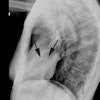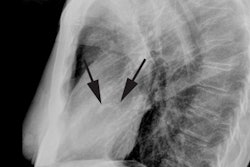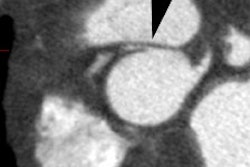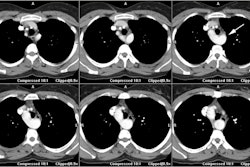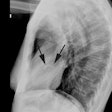Mitral Incompetence (Regurgitation):
View cases of mitral incompetence
Clinical:
The mitral valve is a bicuspid valve. The anterior leaflet is the larger and it is continuous with the aortic valve. Mitral incompetence results in a volume overload which affects both the left atrium and left ventricle. To maintain adequate stroke volume in the setting of mitral regurge, both the LV stroke volume and the ejection fraction increase [2]. In chronic mitral regurge, the ventricle decompresses partially into the left atrium, hence the pulmonary venous system is relatively protected and mitral regurge is one of the best tolerated left sided valvular lesions. Both the LA and LV dilate in response to the chronic volume overload [2]. Indications for surgery in asymptomatic patients with chronic MR include an LVEF of less than 60% or a LV end-systolic diameter of more than 40 mm [2].
Etiologies of mitral valve incompetence include: Rheumatic heart disease (most common cause), mucoid degeneration of the valve leaflets (Marfan's), chordae tendonae rupture, papillary muscle rupture (following MI), endocarditis, and left atrial myxoma. Asymmetric septal hypertrophy (IHSS) will alter the left ventricular geometry and may be complicated by some element of mitral regurge. Clinically there is a mid to late systolic murmur and patients frequently develop atrial fibrillation when the left atrium becomes very enlarged. Most of the regurge occurs in early systole while the aortic valve is still closed.
A flailed mitral leaflet is defined as eversion of the mitral
leaflet tip into the atrium during systole and it is the result of
a ruptured chordae tendoneae [2]. The condition is associated with
severe mitral regurge [2].
Secondary mitral regurgitation occurs frequently in patients with
ischemic heart failure [3]. The condition occurs due to a
combination of reduced LV closing forces (due to LV dysfunction or
dyssnchrony) and global and regional LV remodeling which leads to
distortion of the subvalvular apparatus of the mitral valve,
displacement of the pappillary muscles, tethering of the mitral
leaflets, and failure of mitral valve coaptation [3]. The presence
of secondary mitral valve regurg is associated with increased risk
of heart failure hospitalization and all cause mortality [3].
X-ray:
In the setting of acute onset mitral regurge following MI, the heart may be normal sized with pulmonary edema as the acute hemodynamic changes overwhelm the buffering effect of the left atrium. The pulmonary edema is characteristically localized to the right upper lobe due to blood being preferentially directed in to that location [2]. In the acute setting, left atrial enlargement is also not observed.
In long standing mitral regurge, left atrial enlargement can be identified on chest radiographs (as detailed in the discussion on mitral stenosis below). With long standing mitral regurge the left ventricle becomes enlarged because both the LA and regurgitant volume return to the ventricle during diastole (remember- the LV will be normal sized in mitral stenosis). The amount of left atrial enlargement is generally greater than that seen in association with mitral stenosis (the left atrium protects the pulmonary vasculature from LV pressures by dilating). Pulmonary vascular congestion is said to be less than is seen in mitral stenosis because of protective function of the left atrium. Pulmonary edema may be localized to the right upper lobe in cases of CHF associated with mitral regurge (9% of cases)- because the plane of the mitral valve faces posteriorly, superiorly, and to the right, the regurgitant stream is directed toward the right pulmonary veins, particularly the superior right pulmonary vein [1].
REFERENCES;
(1) Radiographics 1999; Woolley K, Stark P. Pulmonary parenchymal
manifestations of mitral
valve disease. 19: 965-972
(2) Radiographics 2010; Morris MF, et al. CT and MR imaging of
the mitral valve: radiologic-pathologic correlation. 30: 1603-1620
(3) J Nucl Med 2015; Landau SM, et al. Measurement of longitudinal beta-amyloid change with 18F-Florbetapir PET and standardized uptake value ratios. 56: 567-574
